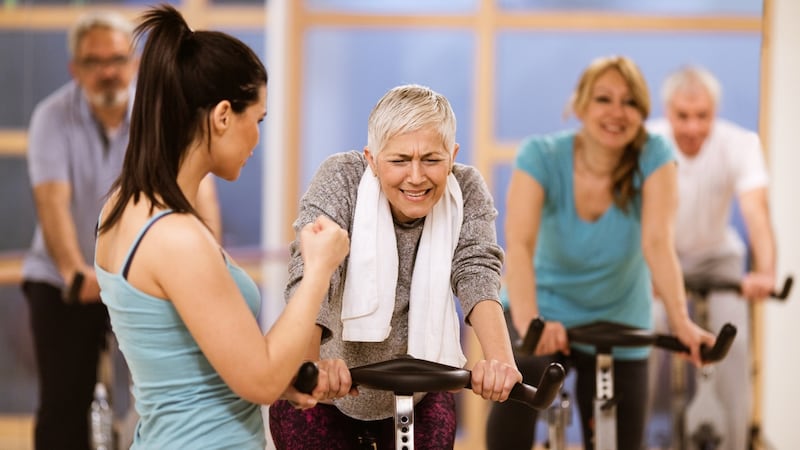Is there any group of people better qualified to comment on fitness habits than personal trainers?
From their vantage point on gym floors, they see our grunting, sweating exertion up close: the peacocking bros, the men who don’t wipe down the machines when they are done – and that woman on the treadmill who is never off her phone.
But what common mistakes do they witness, day after day?
Which fitness myths really wind them up?
And can they answer the burning exercise-related question of our times: is Noel Edmonds right to claim that stretching is a con invented by personal trainers?
1. In the land of the gym machines, technique is king
The number one gripe from all the personal trainers I spoke to was the same: poor technique – not lifting weights correctly, leaning forwards into your squat, or busting out the repetitions, but with the incorrect posture and form. Not only does bad technique risk causing injury, but it is often pointless exertion: your body won’t reap any benefits. Learn to do things properly, and then slow down.
"I'd rather people did two repetitions of a full push-up than 10 repetitions on their knees," says Jermaine Johnson, a personal trainer with the gym chain Blok.
“They’re going to shock their muscles and increase their strength. The body adapts to movement patterns, so the more you do it, the better you’re going to get. I wish people knew that, and worked for quality over quantity.”
2. Fitness classes can be great – but tread with caution
When it comes to poor form, part of the problem may be our growing fondness for fitness classes. Although classes can be a great way to get into exercise – and more motivating than working out on your own – often, instructors don’t demonstrate the exercises for more than a few seconds.
If you are a newbie, it is easy to get things wrong. “If you’re a beginner in a class and you’re doing a deadlift with the wrong technique, you’re going to be in bed for three days with a sore back,” says personal trainer Bradley Simmonds.
He advises beginners to arrive before classes start, and pull the instructors aside for a chat. “Ask your instructor can they show you the proper technique, and then you’re good to go.”
3. Women, lifting weights won’t turn you into Hulk Hogan
Of all the myths that persist around exercise, this is one of the most damaging, as it excludes women from the health benefits of strength training. Lifting weights will help you to stay strong and active into old age, and can reduce your likelihood of having back pain or bone fractures in later life. But many women still avoid the free-weights section because they are concerned that the odd bicep curl will turn them into Hulk Hogan.
“I want more women to know that weights won’t bulk them,” says Johnson. “It’s a mistake to assume that after a few weight sessions, you’re going to wake up looking like a bodybuilder. It takes a very long time to build up muscle.”
Don't feel nervous about venturing into the weights sections. "For women or people from the LGBTQ community, it can be scary even to walk into the section of the gym that has all the weights in it for the first time," says Melanie Stride, a personal trainer and lifting specialist.
She encourages women to educate themselves about the benefits of strength training, and get lifting. “Lifting culture has been seen as very male, very straight and very young. One of the biggest things I do is reassure people outside of those groups that they can do this, in an environment where they feel safe, accepted and part of a community.”
4. You may not be trying hard enough
"I have a friend who used to go to the gym and sit on the bike and watch Diagnosis: Murder," says Sarah Overall, a fitness and nutrition expert. "If you can concentrate on that, you probably need to do a bit more work."
How do you know if you’re working hard enough? “You need to get yourself to a point where you’re feeling breathless, and you can answer questions, but you can’t have a whole conversation,” she says. The odd jog isn’t enough. Adults aged 19-64 are advised by national agencies to do 150 minutes of moderate activity a week, in addition to twice-weekly strength exercises, to stay healthy.
“Just having a little stroll around the park isn’t going to do it,” Overall says. Push yourself. Are you doing as many burpees as you possibly can during your regular HIIT [high-intensity interval training] class? Working to failure – meaning that you exercise to the point of exhaustion – will take your body to the next level, says Johnson.
“If you feel a set was easy, find the point where you’re working to failure – that’s when you know your body is working.”
5. You don’t need fancy gear or boutique-gym membership
Don't be fooled by the yoga bunnies wearing expensive brands on Instagram: you don't need sweat-wicking fibres or seamless running tights to exercise. A T-shirt, a supportive sports bra (if you are female) and a pair of leggings or shorts will be fine. What you shouldn't skimp on, says Overall, are decent trainers.

“Go to a specialist shop, walk on a treadmill so they can look at your gait, and make sure the shoes fit you properly. If you’re not wearing the correct footwear, that can cause injury.”
Even if you cannot afford to join a gym, there is no reason not to get moving. "If you have space in your house or garden, or in a nearby park, that's all you need," says Hannah Lewin, a personal trainer who works exclusively with women. She points to all the fitness content available on YouTube or Instagram, as well as free apps such as Couch to 5K, or Virgin's free marathon training plans.
If you can afford to join a gym, there is usually a personal trainer on the floor who will demonstrate the basic exercises.
6. Leave your ego in the locker room
You know the type – an ego lifter struts about the weights section, loudly grunting as they grapple with the biggest weight they can manage. "There's always going to be the ego lifters," says the personal trainer and disability specialist Rob Ghahremani. "Every gym has one.
“We’ve got an idiot in ours who sprays chalk absolutely everywhere. For the bench press, he’ll load the bar up with 150 kilos and move the weight about as far as I can walk – which isn’t very far.” (Ghahremani uses a wheelchair.) Not only are ego lifters annoying, but they may be causing themselves damage.
“Their technique is often really bad,” says Johnson. “Because they want to look and feel as if they’re working hard, they put maximum stress not only on their muscles, but on their whole body and joints.” It’s also unnecessary: heavier weights aren’t always best. “You can train with a lighter weight and slow down the tempo, focus on your range of movement, and you’ll feel it more than doing bad reps with a heavy weight.”
7. Find your real motivation
In gyms, as in life, it is a good idea to ask yourself what am I doing here. “Everyone should be able to have their own goals for their body,” says Stride. “If you want to get really lean and shredded, I’m not going to cast judgment on that goal. But there are so many other reasons to exercise, whether it’s for your physical or psychological health.”
Overall believes you should train for the body you have, not the body you think you should have. “You can’t really change your basic shape,” she says. “If you’re a natural pear shape, you are always going to be a pear shape. You can reduce your body fat, to make yourself look smaller, but your bottom will still be in the same proportion to your top.”
8. Be realistic about what exercise alone can achieve
If you want to lose weight, exercise isn’t enough – you also need to look at diet. We tend to overestimate the calories we burn in the gym; it is the reason female marathon runners often gain weight while training. Simmonds points out that many people work really hard in the gym, but then think they can eat what they like.
“They give 100 per cent effort, and then ruin it by having a massive meal.” Don’t just smash the cardio. “Throwing yourself into the weights room is where you’re going to get the most effective results,” says Johnson. And if the number on the scales stays the same, don’t be disheartened. “Clients sometimes complain they haven’t lost weight, but they’ve actually lost fat and replaced it with muscle.”
9. Gels and protein powders are best left to the professionals
Beware the siren call of expensive energy drinks and gels. “Unless you’re doing more than 90 minutes of endurance work, you do not need an energy drink,” says Overall. The same goes for protein powders, unless you are actively bodybuilding. Reject the guff and nonsense of the diet culture.

“I work on an anti-diet basis,” says Lewin. “That doesn’t mean I am anti-fat loss, if that’s what you want. But I’m anti-nonsense products, such as fad teas, tablets and raspberry ketones – anything that makes a profit, rather than promoting long-term health.”
10. Don’t do the same thing week in, week out
When it comes to fitness, routine is the enemy of progress. “The body responds to progressive overload,” says Stride, “so unless you progressively overload a movement, you’re never going to move forward. If you don’t ever increase your weights, and you carry on doing the same sets, week in, week out, you’ll maintain your fitness, but you won’t make progress.”
To get the best out of exercise, you need to do a mixture of cardio, strength and flexibility work. “Cardio is going to make you live longer, and make your heart more efficient,” says Ghahremani. “Weight training will strengthen your muscles and lead to stable muscle growth. And flexibility work will stop you putting your back out getting out of bed in the morning. All three are equally important to a good, long, healthy life.”
11. Go at your own pace, and don’t be afraid
If you have the money to hire a personal trainer, be upfront with them about your fears. “If you don’t want to work out until you’re sick, you should never be in a position where you have to do that,” says Overall. “Be honest – if you’re really scared and think this is going to half-kill you, share that with the person training you.”
Disabled people shouldn’t underestimate how much they can do. “Often, they tell themselves they can’t do certain things,” Ghahremani observes, “and they place more limits on themselves than they should. Boundaries can be pushed. You’ve just got to be a bit creative about it.”

If you are older and have health problems, speak to your GP before throwing yourself into fitness, advises Richard Miller, who specialises in training the over-50s. Look at the capabilities of your body, and find exercise that works for you.
“A lot of the guys I see have knackered knees; cycling is low impact, and even better is swimming, which is great body conditioning, but also low impact for people with joint or knee issues.”
12. Don’t listen to Noel Edmonds
Finally, the most urgent fitness question of all: is stretching really a scam invented by personal trainers? Lewin certainly doesn’t think so. “Although sometimes overlooked, stretching has many benefits,” she says, “including increasing flexibility and range of motion and improving posture.”
She advises that you incorporate stretching into your warm-up and cool-down routines, to help the body prepare for movement and recover after a workout. Stride agrees that stretching can be useful, but only if you are doing it right: waving your arms about while standing stock-still isn’t going to do much.
“Static stretching is rarely necessary or an effective use of exercise time for the majority of clients,” she says. “Instead, dynamic [moving] stretches are a great way to warm up, with static holds used only sparingly to access some additional range of motion prior to training.” The verdict is in, then: stretching is not a scam. But, as Edmonds might observe, they would say that, wouldn’t they? – Guardian








